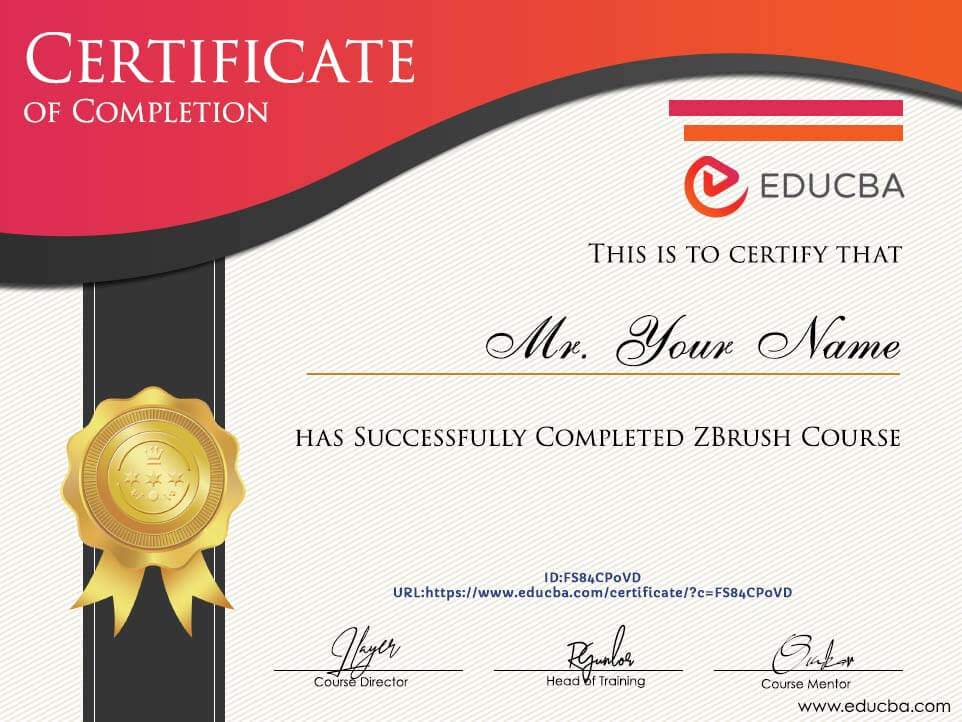ZBRUSH
Specialization | 3 Course Series | 3 Mock Tests
This ZBrush Course includes 3 courses with 17+ hours of video tutorials and One year access and several mock tests for practice. You will also get verifiable certificates (unique certification number and your unique URL) when you complete each of them. Through this course you shall learn digital sculpting that blends 3D and 2.5D modeling, painting and texturing.
Enroll now and get a FREE Exam Voucher worth $285!
Only 27 seats are left with this price
Offer ends in:
What you'll get
- 17+ Hours
- 3 Courses
- Mock Tests
- Course Completion Certificates
- One year access
- Self-paced Courses
- Technical Support
- Mobile App Access
- Case Studies
- Download Curriculum
Synopsis
- Courses: You get access to all 3 courses, Projects bundle. You do not need to purchase each course separately.
- Hours: 17+ Video Hours
- Core Coverage: Rendering, Timeline, Gradient, Shadowbox, X, Y, Z Planes of ZBrush, user interface, ZBrush Dynamesh, Brushes, Zmodeler, Polypainting & Masking, and Rendering
- Course Validity: One year access
- Eligibility: Anyone serious about learning ZBrush
- Pre-Requisites: Basic knowledge of using editing software
- What do you get? Certificate of Completion for each of the 3 courses, Projects
- Certification Type: Course Completion Certificates
- Verifiable Certificates? Yes, you get verifiable certificates for each course with a unique link. These link can be included in your resume/LinkedIn profile to showcase your enhanced digital sculpting and modeling skills
- Type of Training: Video Course – Self Paced Learning
Content
-
MODULE 1: ZBrush Fundamentals
Courses No. of Hours Certificates Details ZBrush - Basics 3h 25m ✔ -
MODULE 2: ZBrush Dynamesh & ZModeler
Courses No. of Hours Certificates Details ZBrush Practical - DynaMesh 7h 22m ✔ ZBrush Practical - ZModeler 6h 59m ✔ -
MODULE 3: Mock Exams & Quizzes
Courses No. of Hours Certificates Details Test - ZBrush Test Series Test - ZBrush Assessment Exam Test - ZBrush Mock Exam
Description
ZBrush offers a combination with Autodesk Maya, Max, Blender, Poser Pro, DAZ Studio. ZBrush was first created by the company PIXOLOGIC INC, which was founded by Ofer Alon and Jack Rimokh in 1999. It is built with an amazing interface that offers users with the most advanced tools. Generally used by today’s digital artist, ZBrush has incredible User Experience that even inspires the artist from within.
The best thing about ZBrush is that the user can sculpt and paint using a huge number of polygons without worrying about buying expensive graphics cards. ZBrush is a highly commercial yet skill-based software, that not only can be used for creating realistic renders but also can be used for 3D printing modeling.
The Zmodeler is designed to help the user in the creation process. It is used for creating powerful and quick new shapes. Fusing polygons, removing full blocks of geometry, connecting parts with new paths with just a single click are some of the uses of Zmodeler.
The most important and used feature of ZBrush is Sculpting. This feature comprises of several sub-tools that can be used by the students for various projects. These tools are 3D brushes, 3D layers, Surface Noise, Transpose, Vector Displacement Maps, Alpha 3D, Lazy Mouse 2.0, Deformations, Projection Master, Instances, MicroMesh, Fiber mesh, HD Geometry.
ZBrush is based on the power of Pixel that takes digital printing to another level. Contrary to the ordinary pixels present in other 2D applications which consists of only color and position info, ZBrush’s Pixel contains color, position, depth, lighting and material info. It is a complex software but still the most advanced and used software for digital sculpting. ZBrush comes with so many different and latest tools and features that distinguish it from others.
Sample Certificate

Requirements
- Basic knowledge about computers is a must
- Passion for Sculpting and Modeling with lots of ideas and imagination is a much-needed pre-requisite before starting this ZBrush training. There should be a desire and dedication to study the software through this course, then only the results would be positive
- To learn the ZBrush course the user needs to have a basic idea of the digital art concept and what 3D modeling is all about. Since the training is based on workable knowledge teamed with various illustrations and skills, the student needs to have a prior understanding of the minor basic needs of modeling.
Target Audience
- This ZBrush Training course targets huge audiences who are willing to build a career in 3D modeling and sculpting.
- The Zbrush course is aimed at audiences who are dedicated to learn and grasp the skills in no time.
- This Zbrush training is not limited to any audience. A beginner or a professional both can use this training.
- If the user desire to become a 3D sculptor and want to work in the Gaming and Film & Television industry as a career in 3D Modeling, then ZBrush happens to be the most demanding software in the market today.
Enroll now and get a FREE Exam Voucher worth $285!
Offer ends in:
Training 5 or more people?
Get your team access to 5,000+ top courses, learning paths, mock tests anytime, anywhere.
Drop an email at: info@educba.com